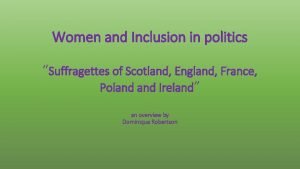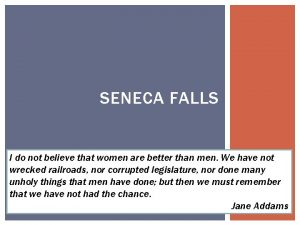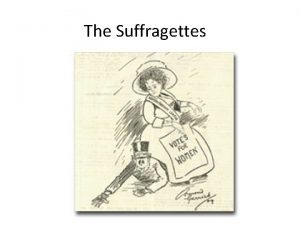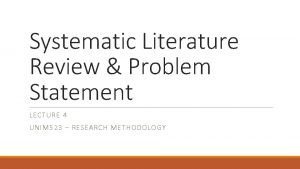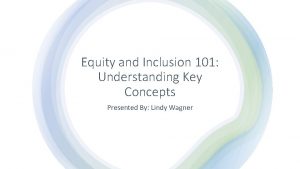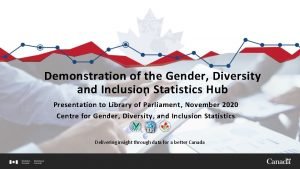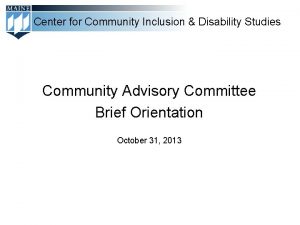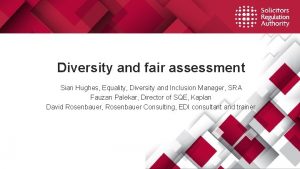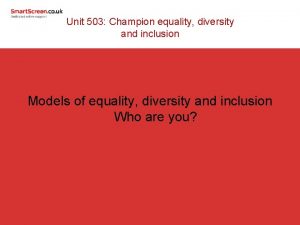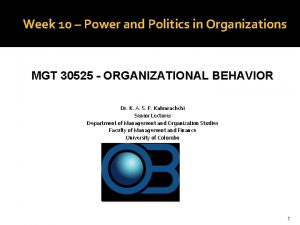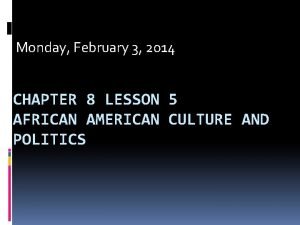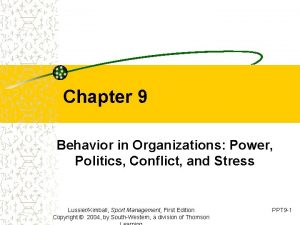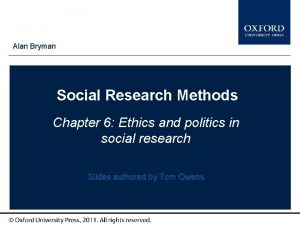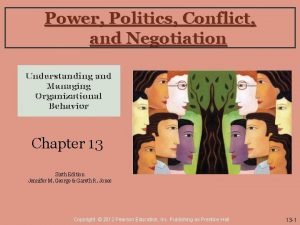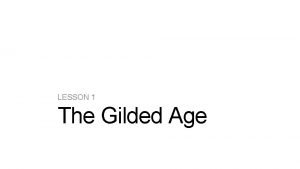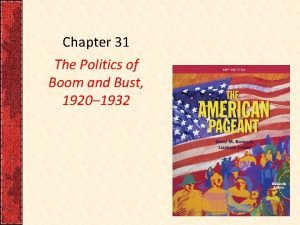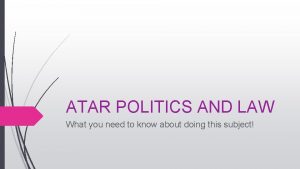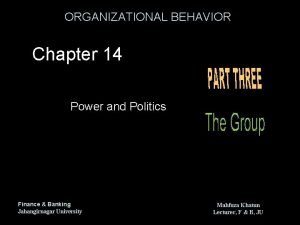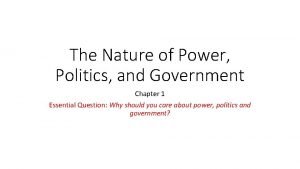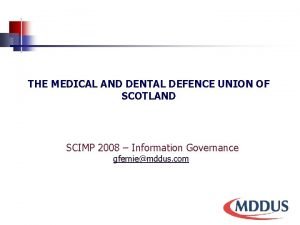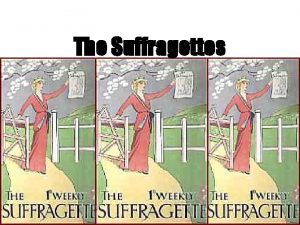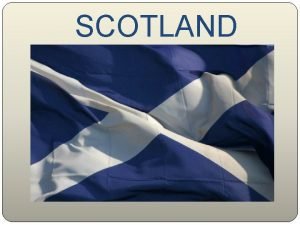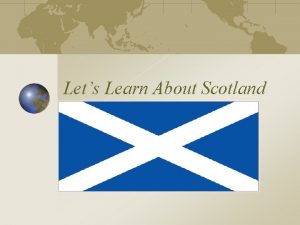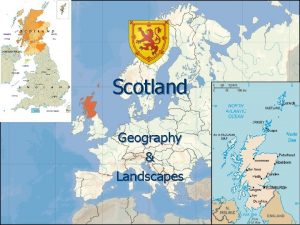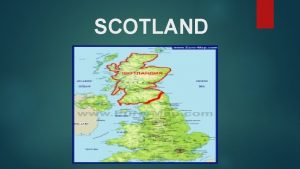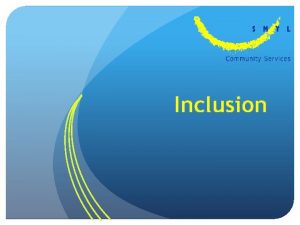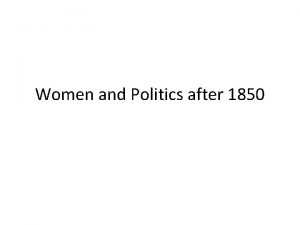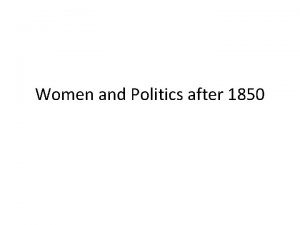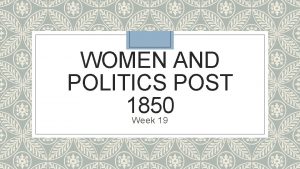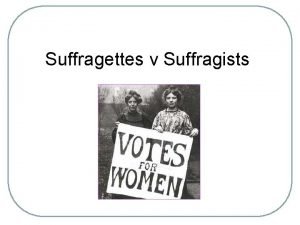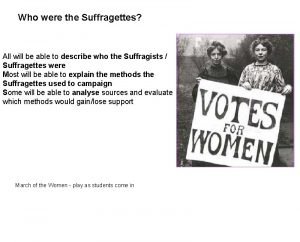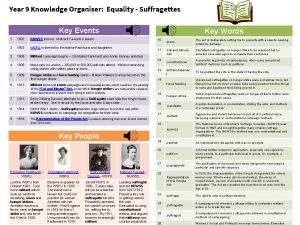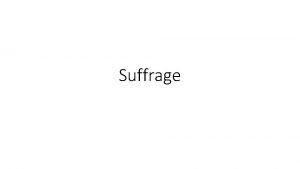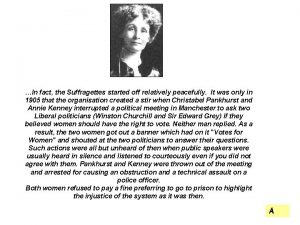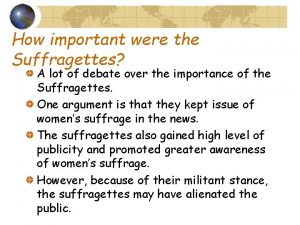Women and Inclusion in politics Suffragettes of Scotland














































- Slides: 46

Women and Inclusion in politics “Suffragettes of Scotland, England, France, Poland Ireland” an overview by Dominique Robertson

British and European women’s voting rights Many women all over Europe had tried to defend their rights as early as the 18 th century. In Scotland, England, France, and Ireland they often had the society, their families, politicians and the Press against them, portraying women in a very derogative and disrespectful way which could be seen in various publications, papers and postcards. In Poland, the situation was a bit different. Those rebels were called SUFFRAGETTES.

Who were these suffragettes? • The word “suffragettes”, although with a French consonance actually originated from England in 1903, from the word SUFFRAGE (vote). A French movement followed 3 years later only. • Suffragettes often came from educated background, sometimes from aristocratic families but were joined on occasion by the working class. One has to remember that they had to pay fines or go to jail for one or two months, which was pretty difficult to manage for women without financial means. • During WWI and WWII, in which women played very active roles and faced extremely challenging situations, including torture, this was still not enough to have the right to vote. • In the UK, they were seen as a potential threat and dealt with in a very dismissive and disrespectful manner, imprisoned and tortured by force feeding, and in France, women were mocked in public and beaten at home, or sexually threatened. • This changed when women from all class backgrounds started to unite.

The WSPU (Women’s Social and Political Union) • Suffragettes was also the colloquial name of the women members of the WSPU. They were often demonstrating but also engaging in a series of small attacks, such as small arsons, breaking windows in protest, assaults without harm (i. e. on police officers) or causing verbal disturbance. • The colours of the British Suffragettes were purple, white and green, as seen here on a brooch:

Why women wanted to vote (dare we ask)? • • • To be autonomous To be equal in civil rights To have access to Education and to influence education To protect factory workers and women abused at work To defend themselves against violent partners or violent bosses To fight prostitution To have a say on healthcare To fight the consequences of alcoholism in their family and social lives To have access to politics To influence policies To challenge immorality

Demonstrations in Edinburgh and London

Same themes in France, same everywhere

…and, in UK, what the Press or other publications had to say about it at the time?



Never forget our Suffragettes… Please vote! • In the UK: In France: In Ireland: In Poland: - Emmeline Pankhurst - Hubertine Auclert - Countess Constance Markievicz - Justyna Budzińska-Tylicka - Emily Davison - Madeleine Pelletier - Eva Gore-Booth - Louise Weiss - Hannah Sheehy-Skeffington - Millicent Fawcett - Ethel Smyth (who composed the March of the Women in 1910, becoming the WSPU official anthem) - Edith Margaret Garrud (a martial instructor and Jiu-Jitsu) - Anna Munro and Jennie Mc. Callum of the Women’s Freedom League (from Dunfermline) - Grace Cadell, President of the Leith branch of the WSPU and a Doctor caring force-fed women out of jail - Ethel Moorhead, known for throwing an egg at Winston Churchill in Dundee and first person to be force-fed - Flora Mc. Kinnon Drummond, nicknamed The General for heading marches, was a great orator. Imprisoned many times. - Elsie Inglis, Scottish Doctor, also founder of the Scottish Women’s Hospitals and secretary of the Edinburgh National Society for Women’s Suffrage

So, were all men against the vote for women? • Actually no, some politicians played a crucial role in Parliament! • For example, MP Keir Hardie, first Labour Member of Parliament, regularly questioned and challenged Government ministers on the force-feeding treatment experienced by the Suffragettes. • A socialist MP George Lansbury, fought for causes such as women’s rights, world disarmament and social justice. He actually resigned his post to support the Suffragettes and give speeches, notably one at the WSPU rally where he expressed his support to the Suffragettes’ campaign of arson attacks – for which he was imprisoned! • He spent his final years travelling abroad to promote peace.

NON POLITICIANS IN SUPPORT OF THE SUFFRAGETTES Some men played a very active part in supporting the Suffragettes, and even went to jail, as did Baron Frederick Pethick-Lawrence who was the editor of the publication 'Votes for Women' together with his wife Emmeline. He was jailed, went on hunger strikes and was force-fed on many occasions. He became an MP from 1923 to 1931, remaining a very influential member of the Parliament in later life as an elder statesman in the House of Lords.

But when it transpired that some things might change, men were then mocked or portrayed as the new victims, or the weak ones…

Or maybe were they in fear of THE unthinkable…?


A Suffragette of Dunfermline • Jeanie Mc. Callum (1881 -1946) was a Suffragette from Dunfermline. • She came from a workers’ family and was a linen worker herself • She joined the Women’s Freedom League, a break away group from the WSPU • She defended the rights to vote and went to jail for “creating a scene in the Lady’s Gallery of the House of Commons” • She went to jail with 14 other Suffragettes, refusing the alternative sentence to pay a £ 5 fine or a month imprisonment. She opted for the jail sentence. (Some Suffragettes could not afford such a sum). • She later married an engineer (Harry Richardson), went to live in South Africa where she died. They had 3 children.


Meanwhile in Europe, women’s voting rights:

French women and voting rights • Surprisingly for a country having gone through a Revolution in 1789, creating a Republic revendicating “Liberté, Egalité, Fraternité”, it took another 155 years before French women could vote. • However, they were allowed to pay taxes, do war duties, be part of the Résistance, be tortured by the enemy, or do hard physical works in factories or in farms when men were at war. • At the end of WW 2, Charles de Gaulle considered their rights at last, and gave them access to vote. He needed their votes too… • Therefore, the first time women could exercise their voting rights was only in May 1945!

Translation It says that women CAN pay taxes, actually that all men and all women can BUT The persons who are deprived of voting rights are: - Under-age persons, children - people with life imprisonment sentences - and all women…

Irish women and voting rights • The Suffragette movement in Ireland was depicted as “an amusing side-show” by the Press, but there was quite an active group of educated women AND men challenging the Irish society at the time. Many men campaigned for women to get the right to vote, which happened in 1918 (for some women only, under conditions). • The Irish Women’s Franchise League (IWFL) was the Irish equivalent of the WSPU in Britain, and founded by a husband wife – Hanna and Francis Sheehy-Skeffington. For the little story, they were not quite a couple of their time, describing themselves as “vegetarian pacifists” who took each other’s name when they got married! They also founded together the very first feminist newspaper called the Irish Citizen (equivalent to the Votes for Women in UK). • The treatment of Irish women in the criminal justice system in cases of violence against them was a real source of grievance as the law was quite laid-back and tolerant towards men committing violence on women. . . • The women’s campaign to be able to vote was therefore only one aspect of their campaign. • That said, the 50 th anniversary went practically unnoticed in 1968. To give an idea, in 1968, only 9 women out of 204 were members in an Oireachtas (the legislature of Ireland). They were actually outnumbered everywhere in public life…


Irish Suffragettes carrying a banner “From Prison to Citizenship”. Each of the 617 arrows represented a conviction of a suffragette…

Polish women and voting rights • A decree on electoral rights was signed on the 28 th November 1918, enabling all citizens (men and women) over the age of 21 to take “active and passive participation in elections”. • Poland was one of the first European countries to grant this right, one year before even the USA did. • That said, it was not that straightforward. A group of women headed by Doctor and Social Worker Justyna Budzińska-Tylicka went to the house of then Head of State Pilsudski to speak to him about women’s rights, knocking at his door, asking to be heard but he left them outside for hours in the terrible cold. • From 1919 though, which was the first election in the Second Republic, eight women were elected to the Parliament (out of 364, that is 2% only). • They mostly dealt with matters re education, health or women’s rights.

Polish women and acts • These elected Polish female deputies opposed discrimination in the granting of teaching allowances • They fought for the withdrawal of provisions removing citizenship from Poles who had married a foreign person. • They lobbied to build schools and improve the lives of poor children • They abolished the form of taxation on prostitution - prostitutes had to pay a compulsory rate in a public house to third parties. • They helped combat the trafficking of women and children • They worked on a new social welfare law • They passed a bill on the sale and manufacture of alcohol

Polish Suffragettes demonstrating in 1911

VOTING RIGHTS’ DATES • British women voted long before French women could: they were granted the right to vote in 1918, but only for women over the age of 30, and… “with property”. They got full rights over the age 21 in 1928. • In Ireland, women could also vote in 1918, again, on the condition “to be with property qualifications or in university constituencies”, age 30. Irish men though could vote age 21 – with no qualification. It is only in 1922 that the Irish Free State gave men and women equal voting rights. • In Poland, women were one of the first ones to vote in Europe in 1918, without any conditions!

IN UK, WOMEN WERE FIRST MOCKED, THEN CAME THE REPRISALS When the people in power started to realise that women’s political engagement and dedication to voice their rights to vote would not be altered, they started to take them seriously, and listened to them – but not in a way as one would have expected. They were humiliated, arrested, and put in jail. Women had nothing to lose: many of them had some miserable lives and the only way to adjust the issues they faced on a daily basis was to be able to vote, for them to have a direct say and be able to act and be democratically represented.

In jail, suffragettes were on hunger strikes and began to be force-fed, twice-daily…

Only one doctor in Scotland accepted to force -feed the Scottish suffragettes, a very painful torture where a long tube was put down into the stomach and led to some women being left with permanent damage and difficulties swallowing, or even digesting food for years to come.

…but came the Cat and Mouse Act 1913, the Prisoners Parliamentary Act:

How important was the Cat and Mouse Act? • Thankfully, there was a public outcry at the way Suffragettes serving a prison sentence were treated in jail, the force-feeding that is… • This Act allowed the Suffragettes to be released when their hunger strike was starting to affect their health. • They were given some time to recover, and were rearrested once in good shape to complete the rest of their sentence. • This, technically, was legalising hunger strikes.

What’s in the Cat’s? This Act was given the nickname of Cat and Mouse Act 1913 for it was kind of describing the situation: - a domestic cat playing with its prey, letting it escape several times but only on a temporary basis…and then it would kill it…

THE STORY OF SUFFRAGETTE EMILY DAVISON Emily Wilding Davison was arrested 10 times, was 7 times on a hunger strike and force-fed 49 times. . .

Emily Wilding Davison, before and after forcefeeding treatments

On Emily Wilding Davison’s accident: Emily Davison was hit by King George V’s horse Anmer on the 4 th June 1913. The accident was captured on a film. She died 4 days later. A recent analysis of the film footage now indicates that she seemed to have tried to attach a suffragette banner to the horse collar. A few minutes before, she had placed a bet on a horse and had a meeting scheduled after the event… It was not a suicide.

A telegram sent by Queen Alexandra (mother of King George V) to the jockey, emerged for the first time at the beginning of 2018, and reads: “Queen Alexandra was very sorry indeed to hear of your sad accident caused through the abominable conduct of a brutal lunatic woman”. …continuing with kind words towards the jockey: “I telegraph now by Her Majesty's command to enquire how you are getting on and to express Her Majesty's sincere hope that you may soon be all right. ” Emily Davison died 4 days later and the jockey was back riding 2 weeks later.

Emily Wilding Davison’s fatal injuries • Her accident • Her funeral

Meanwhile, in France, learning from the British suffragettes, women chained themselves together when demonstrating to avoid been separated…

12 th May 1935: Suffragettes lead by Louise Weiss chained themselves together while demonstrating to have the right to vote.

SUFFRAGETTES’ DEMONSTRATIONS BOARDS FROM ALL OVER EUROPE: WOMEN UNITED!

In May 1936, French women rallied to fight for the rights to have paid holidays and a 40 -hours week working pattern. Still, despite the Depute Chamber adopting the right for women to vote, and this presented on 6 occasions between May 1916 and May 1936, the Senate still refused to even consider the text! Women had to wait for another 9 years…

Sometimes, Suffragettes were organising dummy elections, i. e. in France on the 5 th May 1935, which collected more than 100. 000 votes!

The right to vote at last! Adopted on the 21 st April 1944, French women will vote for the first time on the 29 th April 1945.

The Great Tapestry of Scotland has dedicated a panel ‘Women get the Vote’ featuring the Suffragettes of Scotland with the Soroptimist International GBI logo in a smaller corner panel, which will now tour the World…
 A suffragettes home
A suffragettes home A suffragettes home
A suffragettes home For or against
For or against Wspu suffragettes or suffragists
Wspu suffragettes or suffragists England and scotland both produce scones and sweaters
England and scotland both produce scones and sweaters Literature review problem statement example
Literature review problem statement example What is inclusion and exclusion
What is inclusion and exclusion What is the inclusion and exclusion criteria in research
What is the inclusion and exclusion criteria in research California map to inclusion and belonging
California map to inclusion and belonging Diversity, equity and inclusion 101
Diversity, equity and inclusion 101 Diversity and inclusion scorecard
Diversity and inclusion scorecard Bhiss
Bhiss Centre for gender diversity and inclusion statistics
Centre for gender diversity and inclusion statistics Center for community inclusion and disability studies
Center for community inclusion and disability studies Diversity and inclusion consulting
Diversity and inclusion consulting Centre for gender diversity and inclusion statistics
Centre for gender diversity and inclusion statistics Etsu equity and inclusion conference
Etsu equity and inclusion conference Diversity and inclusion maturity matrix
Diversity and inclusion maturity matrix Diversity training outcomes
Diversity training outcomes Dei pulse survey
Dei pulse survey Stevenson and black 2007 inclusion spectrum
Stevenson and black 2007 inclusion spectrum Hse diversity equality and inclusion strategy
Hse diversity equality and inclusion strategy Mona talent priority
Mona talent priority Champion equality diversity and inclusion
Champion equality diversity and inclusion Pta diversity and inclusion
Pta diversity and inclusion Power and politics in organizations
Power and politics in organizations Opportunities and challenges in media and information ppt
Opportunities and challenges in media and information ppt Lesson 5 african american culture and politics
Lesson 5 african american culture and politics Bureaucracy and politics in india
Bureaucracy and politics in india Power, politics and conflict in organizations
Power, politics and conflict in organizations Ethics and politics in social research bryman
Ethics and politics in social research bryman Conflict power and politics
Conflict power and politics Philosophy, politics and economics michael munger
Philosophy, politics and economics michael munger Lesson 1 - politics and the gilded age
Lesson 1 - politics and the gilded age Chapter 31 the politics of boom and bust
Chapter 31 the politics of boom and bust Chapter 20 whose government
Chapter 20 whose government Politics and international relations bsc
Politics and international relations bsc Ap government unit 1 study guide
Ap government unit 1 study guide Politics and law atar
Politics and law atar Relationship between sport and politics
Relationship between sport and politics Politics and the english language
Politics and the english language Power and politics organizational behavior
Power and politics organizational behavior Power and politics organization theory
Power and politics organization theory Power and politics
Power and politics The nature of power politics and government
The nature of power politics and government Dental defence union
Dental defence union National risk and resilience ambulance
National risk and resilience ambulance

